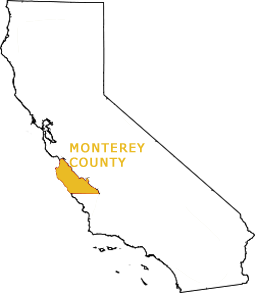The geology of the Monterey region, like much of California, is tied to the San Andreas fault. The continuous tectonic movement compressed the silica-rich rock laid down in Miocene time, approximately 16 to 6 million years ago, folding and fracturing them and, over eons, piling them up into the growing Monterey Formation. It is an awe-inspiring sight to see the stunning, layered rock outcroppings, such as those that jut out along the south flank of Morro Bay. The layers and layers of rock are reminiscent of the rings on the inside of a hundreds-year old oak tree. The millions of years of geological history contained in the strata of the Monterey Formation are of major importance in understanding the complex past of Monterey’s creation.
Monterey County, California
This accident of geological history is the key to Monterey’s success in cultivating top-notch wine grapes. The ideal climate, soil and water combine to create superb growing conditions.
CLIMATE: Flanked by the Gabilan mountain range to the east and the Santa Lucia Mountains to the west, the Salinas Valley maintains its cool coastal conditions due to the influence of the Monterey Bay. Under these waters lies the deepest submarine gorge on the West Coast of the Unites States, known as the Monterey Canyon. As massive as the Grand Canyon, this steep, twisting phenomenon almost perfectly bisects the seafloor of the bay and cases a condition called upwelling.
Upwelling brings the frigid water of the deep sea to the surface, cooling the marine air that hovers over the Monterey coast. Each day, the rising hot air form the Salinas Valley pulls the chilled marine air down its corridor. This cooling down effect allows grapes to ripen more slowly and evenly, resulting in a growing season that can be up to two months longer than other wine-growing regions. In winegrowing, longer hang-time means increased flavor intensity, richer texture, and deeper color.
SOIL: The east side of the valley is the Monterey Formation and it is actually a couple of million years older than the west side of the valley. For millennia it was a sea bed where many different organisms formed and decayed. The gradually sloping alluvial fans of the source vineyards for our Formation wines contain soils that are mainly derived from the Monterey Formation, composed of shale, mudstone, siltstone and limestone. These soils are calcareous (carbonate-rich) and siliceous (silica-rich). The moderate permeability allows for excellent penetration of the roots of the vines, with depths of 60 inches.
WATER: The Salinas River runs 175 miles, making it the largest river of California’s central coast. Most of its flow is underground and it is the longest underground river in America. It is fed by the major tributaries of the Nacimiento and San Antonio Rivers. Grape growers have relatively low usage of water but when they need it, it needs to be available and pure. The formation of the Salinas River, believed to have occurred due to the uplift of the Coast Ranges several million years ago, is another lovely accident of geological history that resulted in the stellar Monterey County wine grape growing region.
